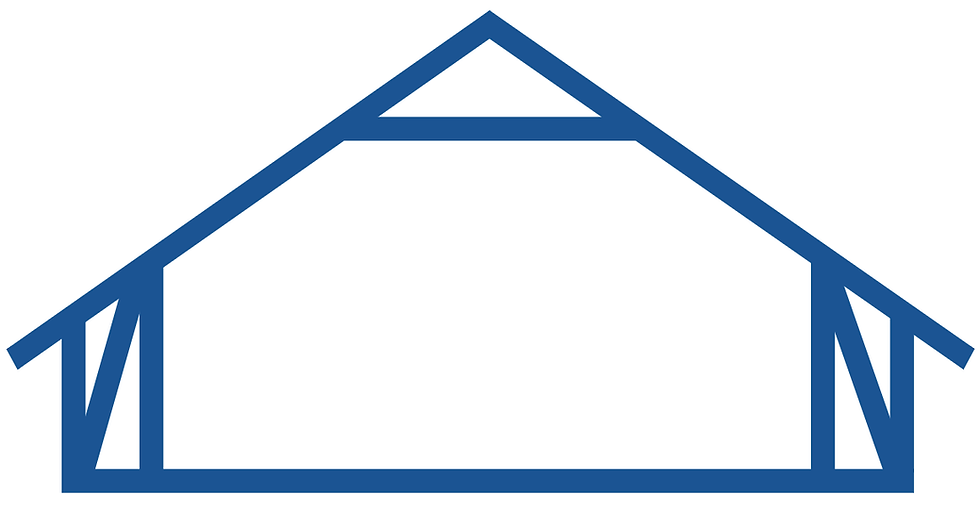What is the difference and benefit of an attic truss versus a stubbed truss
- Milestone Roof Lifts
- Nov 19, 2024
- 5 min read
Understanding Attic Truss In Comparison To Stubbed Truss in Loft Conversions and Roof Lifts
When planning a loft conversion, it's crucial to understand the differences between an attic truss, and stubbed truss (also called a stepped truss). These terms refer to different types of roof structures, each with its own implications for the space available and the potential for conversion.

Attic Truss
An attic truss, also known as an eaves truss, combines the features of an attic and a truss to create a functional space below the pitched roof of a house. This type of truss is designed to provide both structural support for the roof and additional storage or living space in the attic.
The height and structure of an attic truss can vary depending on the specific design of the house. Some attic trusses may have enough room for a loft conversion without major structural changes, while others may require alterations to create sufficient headroom.
Traditional cut roof trusses are typically made from timber and consist of a series of triangles that provide stability. However, attic trusses have a web-like structure that can pose challenges for loft conversions. Converting an attic truss often involves adding steel beams to support the new floor and create additional headroom.
Overall, an attic truss offers the advantage of combining the functionality of an attic with the structural support of a truss, making it a versatile option for homeowners looking to maximise their roof space.

Stubbed Truss
A stubbed truss is a modified version of a standard truss. The lower section of the truss is 'stubbed' off to create more room internally without raising the overall roof ridge height. This can be particularly beneficial where planning restrictions prevent changes to the external appearance of the house. A stubbed truss can provide more usable space in the loft without altering the roofline.
Below is an example of a completed roof lift loft conversion using a stubbed truss to quickly lift the roof line and increase the usable internal space.

Benefits On The Completed Project
The type of roof structure you have will greatly impact your loft conversion project. An attic may require minimal structural changes, while a truss or stubbed truss may require more extensive work as the external brickwork will need to be built up to meet the roof line.
However, a stubbed truss can offer the advantage of increased internal space without affecting the external appearance of your property. This can be a major benefit if you are restricted by planning regulations.
By lifting the internal height, a stubbed truss may be the only option for buildings with a minimal depth where a dormer is not viable or desired.
Visual Representation
Below, is it visual of an attic, truss overlaid onto the same stubbed truss. As you can see the left of the truss, whilst maintaining the same ridge height, greater overall space in the finished loft. The additional space is represented by the red outlined area.

Comparison Table
Here is quick summary of the core differences between the two trust replacement options.
Attic Truss | ||
Head Height | Has the same central head height as a stub truss, but has less height as you move to the external wall. | More head height overall, and may negate the need for a dormer to create the same usable footprint. |
Room Width | Typical not as wide as the stubbed truss as strengthening encroaches further into the room. | The room width is usually wider, given a great overall foot print as well as walkable footprint. |
Project Completion Time | This is generally quicker as no additional brickwork is required | Extended installation time due to uplift in brickwork. |
Eaves Storage | This truss style usually allows for eaves storage beyond the ashlar wall. | Typically, less usable due to additional strengthening required for this type of layout. |
Cost Implications | This is the cheaper of the two options as no external brickwork is required other than the gables being lifted to the new roof height. However a dormer may be required to create the same usable foot print, which adds cost. | In a straight comparison, this is a more expensive option due to the uplift in brickwork and/or render. If this removes the need for dormers, then may be more cost neutral or cheaper. |
Frequently Asked Questions
Can a loft have both a stubbed truss and an attic truss?
Yes, you can merge the two such as using a stubbed truss on one elevation only, i.e. the rear elevation. however, there are multiple options and this can be discussed as part of a design review.
Are there other truss layouts available?
Whats the maximum size for a stubbed or attic truss?
What is the maximum pitch for a loft conversion truss?


Comments